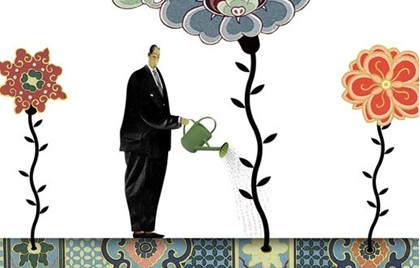
『一些发展中国家的企业走上了绿色增长之路。』
Green growth
绿色增长
Sep 17th 2011 | from the Economist

THE enrichment of previously poor countries is the most inspiring development of our time. It is also worrying. The environment is already under strain. What will happen when the global population rises from 7 billion today to 9.3 billion in 2050, as demographers expect, and a growing proportion of these people can afford goods that were once reserved for the elite? Can the planet support so much economic activity?
Many policymakers adopt a top-down and Western-centric approach to such planetary problems. They discuss ambitious regulations in global forums, or look to giant multinationals and well-heeled NGOs to set an example. But since most people live in the emerging world, it makes sense to look at what successful companies there are doing to make growth more sustainable.
A new study by the World Economic Forum (WEF) and the Boston Consulting Group (BCG) identifies 16 emerging-market firms that they say are turning eco-consciousness into a source of competitive advantage. These highly profitable companies (which the study dubs “the new sustainability champions”) are using greenery to reduce costs, motivate workers and forge relationships. Their home-grown ideas will probably be easier for their peers to copy than anything cooked up in the West.
The most salient quality of these companies is that they turn limitations (of resources, labour and infrastructure) into opportunities. Thus, India’s Shree Cement, which has long suffered from water shortages, developed the world’s most water-efficient method for making cement, in part by using air-cooling rather than water-cooling. Manila Water, a utility in the Philippines, reduced the amount of water it was losing, through wastage and illegal tapping, from 63% in 1997 to 12% in 2010 by making water affordable for the poor. Broad Group, a Chinese maker of air conditioners, taps the waste heat from buildings to power its machines.
These firms measure themselves by their greenery, too. Florida Ice & Farm, for example, links 60% of its boss’s pay to the triple bottom line of “people, planet and profit”. The sustainability champions also encourage their workers to come up with green ideas. Natura, a Brazilian cosmetics company, gives bonuses to staff who find ways to reduce the firm’s impact on the environment. Woolworths, a South African retailer, claims that many of its best green ideas have come from staff, not bosses.
In emerging markets it is hard for companies to stick to one specialism, because they have to worry about so many wider problems, from lousy infrastructure to unreliable supply chains. So the sustainability champions seek to shape the business environment in which they operate. They lobby regulators: Grupo Balbo, a Brazilian organic-sugar producer, is working with the Brazilian government to establish a certification system for organic products. They form partnerships with governments and NGOs. Kenya’s Equity Bank has formed an alliance with groups such as The International Fund for Agricultural Development to reduce its risks when lending to smallholders.
The firms also work hard to reach and educate poor consumers, often sacrificing short-term profits to create future markets. Masisa organises local carpenters into networks and connects them to low-income furniture buyers. Broad Group has developed a miniature device for measuring air pollution that can fit into mobile phones. Suntech, a Chinese solar-power company, has established a low-carbon museum to celebrate ways of reducing carbon-dioxide emissions.
One could quibble with BCG’s analysis. Phil Rosenzweig of Switzerland’s IMD business school has argued that management writers are prone to “the halo effect”: they treat the temporary success of a company as proof that it has discovered some eternal principle of good management. The fact that some successful companies have embraced greenery does not prove that greenery makes a firm successful. Some firms, having prospered, find they can afford to splurge on greenery. Some successful firms pursue greenery for public-relations purposes. And for every sustainable emerging champion, there are surely 100 firms that have prospered by belching fumes into the air or pumping toxins into rivers.
Nonetheless, the central message of the WEF-BCG study—that some of the best emerging-world companies are combining profits with greenery—is thought-provoking. Many critics of environmentalism argue that it is a rich-world luxury: that the poor need adequate food before they need super-clean air. Some even see greenery as a rich-world conspiracy: the West grew rich by industrialising (and polluting), but now wants to stop the rest of the world from following suit. The WEF-BCG report demonstrates that such fears are overblown. Emerging-world companies can be just as green as their Western rivals. Many have found that, when natural resources are scarce and consumers are cash-strapped, greenery can be a lucrative business strategy. (766 words)
特别声明:①凡本网注明稿件来源为"原创"的,转载必须注明"稿件来源:育路网",违者将依法追究责任;
②部分稿件来源于网络,如有侵权,请联系我们沟通解决。
25人觉得有用
23
2011.10
根据2012年考试大纲的新规定,《中国近现代史纲要》(以下简称“纲要”)稳中有变。&ldqu......
23
2011.10
一、 试题构成 自从2010年,英语(二)阅读理解部分增加了新的题型,即阅读理解B节,本部分有三种......
23
2011.10
2012年考研英语大纲中规定的写作A部分的备选题型就包括应用文的写作,要求考生根据所给情景写出约......
23
2011.10
又来到这个多愁善感的时节。往年此时总会因内心感情的澎湃而产生写作的激情。然而,不知是因为考研......
23
2011.10
这几天在论坛看见很多人都说考220是必须的、肯定没问题的!!我想问问你们真正了解管理类联考吗??个......
23
2011.10
简单粗暴考研方法: 1.分析自己技术特点 报考专业形势 对于大众化的专业 我觉得"英语保过线-......